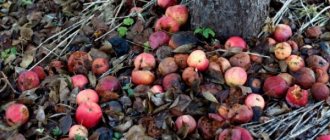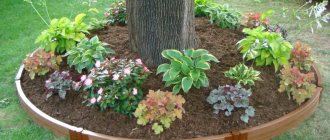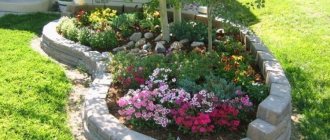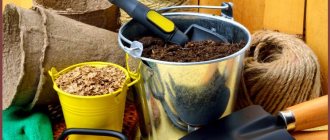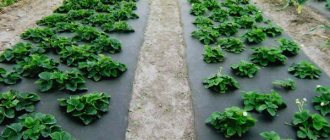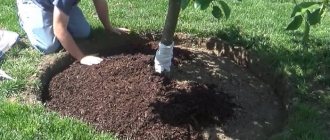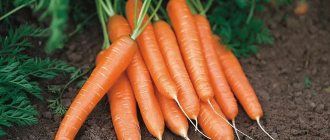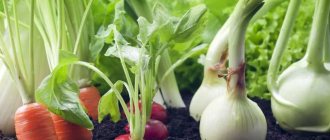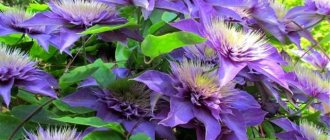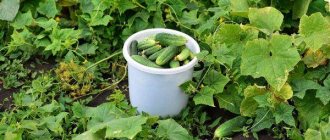Rules for planting plants in the tree trunk circle
It is better to arrange a bed in the tree trunk immediately after planting the tree. It is necessary to remove weeds and add fertilizer, and check the soil for acidity. If it is increased, then dolomite flour is added to the ground.
Apple tree is the most popular fruit tree
It is added at 0.5 kg per 1 sq. m.
When organizing a bed in a tree trunk circle, the following must be taken into account:
- Before planting, you should choose a seedling whose roots will not go deep into the soil.
- The quality of the soil, the amount of lighting and humidity must correspond to the variety of apple tree.
- If you plan to plant other edible crops under the apple tree, then there is no need to treat the tree with toxic chemicals and fertilizers, since the roots of other crops, for example, berry bushes, will absorb these substances.
- It is recommended to make beds 80-90 cm wide.
- Plants should be planted at a distance of 15-20 cm from the tree. If the tree has a graft, then the bushes are located at a distance of 1 m.
- Shrubs should be planted so that they do not grow densely and their foliage does not interfere with apple picking.
- The lower branches of the tree should be trimmed so that they do not inhibit the growth of the bushes.
Note! If the flowerbed is made too large in diameter, it will be inconvenient to loosen, water and fertilize.
Country style composition
Sometimes people, tired of busy city life, want a rural idyll.
Photo: Eksmo Publishing House
Range
Composition size 4.5×1.2 m
Photo: Eksmo Publishing House
A bright and cheerful flower garden in a rustic style is located under a mature apple tree. Fragrant sweet peas are planted in a circle near the trunk, which curls along cords tied to the tree. It blooms from July to September, and although it feels best in open places, it can also tolerate slight shading. Also liked in partial shade are foxgloves with large white, pink, cream or purple flowers on tall stalks. Many gardeners are fascinated by the delphinium blooming in July. To prevent its stems from falling, they must be tied up. At some distance from the tree, a climbing rose with yellow flowers on a support is planted, and under it are rose bushes of the floribunda garden group. In a village flower garden there will definitely be a place for lilies: after flowering they are covered by a large hosta. The composition is decorative from spring to autumn. In May, Aubrieta and Armeria maritima bloom. Since June, aquilegias, foxgloves, delphiniums, hybrid carnations and roses have taken up the baton, continuing to bloom until frost. Asiatic lilies and astilbes bloom in July.
Aquilegia. Photo: From personal archive/ Alexander Kabanov
What does the crown of a tree give?
How to plant mint in the country - how it reproduces
A tree provides diffused shade to plants, which protects them from sunlight. At the same time, the tree-trunk shrubs receive the required amount of lighting. The roots of the apple tree are located widely. This means that they will not damage the root system of other plants.
Planting under the canopy provides the following benefits:
- Plants receive moderate amounts of sunlight and shade.
- More moisture and other nutrients reach the roots.
- It decorates the area, because flower beds can be grown near the trunk.
The tree trunk circle can be used for garden decoration
The tree trunk circle provides additional opportunities for garden creativity. It can be an excellent place for site decoration.
What can you plant under an apple tree?
As a rule, the diameter of the tree trunk circle corresponds to the size of the tree crowns. It is from the tree trunk that water, vital nutrients for the tree and air for the roots come. The structure of the apple tree crown can be dense, sparse or openwork. The leaves on the spreading branches of the apple tree create light shade, and thus the area under the canopy becomes an excellent place for many shade-tolerant plants to grow.
Moreover, such plantings give an interesting twist to any design, and for the roots of the apple tree there are continuous advantages (the soil will not be dry).
There are several options for using the space near the trunk of an apple tree: sodding, planting flowers, vegetables, herbs.
What trees can be planted nearby?
How to plant mint and grow from seeds in the country
When choosing what can be planted next to the apple tree, it is necessary to take into account the compatibility of the plants and the characteristics of the soil. Thus, experienced gardeners allow the joint planting of apple trees and some vegetable or berry crops, as well as shrubs and trees:
Next to the apple tree you can place:
- Pears and plums. The main rule is not to plant them too close to the crown, as the foliage of the apple tree can block sunlight for other crops.
- Cherry and apple tree. The apple tree will grow well, but the cherry tree will not give a good harvest.
- Sweet cherries have a beneficial effect on the growth and ripening of apple fruits.
These trees are not only good neighbors, but also successful predecessors according to the rules of crop rotation. It is permissible to grow apple seedlings in their place.
What neighborhood doesn't love an apple tree?
There are plants that need to be planted away from the apple tree, otherwise the risk of pests, the development of diseases and deterioration in the quality and quantity of the harvest increases:
- It is undesirable for an apple tree to be adjacent to trees and shrubs such as hazel, hawthorn, elderberry, acacia, viburnum, peaches, and bird cherry. During flowering, these trees attract pests that are dangerous to the apple tree.
- You should not plant white cabbage, carrots, onions, mint, or sage around the crop. The growth and development of trees is adversely affected by potatoes planted nearby.
- You cannot plant lilies of the valley around apple trees. Their root system has a bad effect on the roots of the fruit tree.
If you follow all these rules, you can make the most of every piece of land on your site without losing the harvest. Flowers will not take up much space, will create comfort and help improve the health of the earth.
Flowerbed in a tree trunk circle
All about poppy: what it looks like, can it be grown in the country
A flower garden is one of the colorful ways to decorate the tree trunk area and decorate the garden. A flower bed around an apple tree can consist of several flowers of the same type or many different varieties.
What flowers can be planted under an apple tree:
- Bells and forget-me-nots will bloom under the thick crown. You can also plant ferns that are shade tolerant.
- If the crown is sparse and allows light to pass through, then nasturtium, daisies or pansies are planted under the tree.
- Suitable perennial primroses such as snowdrops, muscari, crocuses, daffodils or early varieties of tulips
You can plant different types of flowers in a flowerbed
Note! Some gardeners plant celandine under fruit trees, which repels ants and other insects. Such a flowerbed under the apple tree will not only protect the roots of the tree, but will also help decorate the area.
Flowers in an orchard: what can be planted and how to care for them
Flower crops for planting in tree trunks
The garden was filled with flowers gradually, occupying shady places where vegetables could no longer fully grow.
Now, under almost every tree and between the berry bushes, where there is space and light, flowers have settled, forming mini-gardens of continuous flowering, each different from the other. There are not so many species of flowering plants, but unpretentious ones have been chosen that can be partners for everyone else. Crocuses, primroses, early daffodils delight the eye in the garden in spring. The very first ones to awaken in the spring are crocuses , galanthus , chionodoxes , and scyllas . The paths are framed by primroses of different types and colors and daisies . daffodils and early tulips bloom , located in groups in different places in the garden. Blue muscari border the borders of mini-flower beds, surrounding bergenia and white grouse . Portrait flowers of pansies ; they independently move around the garden by self-sowing.
Every year, new types of perennials always appear in the garden, which neatly fit into the remaining gaps in the flower beds. We were all amazed by the gigantic size of the leaves and the height of the tall elecampane , the seeds of which were given by someone without warning about its gigantism. But its thread-like golden petals and the dense core of the baskets, which so attract butterflies and bumblebees, delight the eye from mid-July and unusually decorate the garden. Interspersed with cinquefoil with bright yellow flowers and hybrid gravilata with scarlet flowers also noticeably enlivened the flower beds.
Bright gravilate is shade-tolerant and feels good in the garden
I would like to say a special word about feverfew , which has magnificent garden forms up to 70-100 cm high, with double inflorescences. They are more reminiscent of bouquet small-flowered chrysanthemums, but botanists say that they are still pyrethrum. The snow-white reed flowers of the outer rows give way to yellowish ones, which surround a small light yellow center with tubular flowers; in general, their inflorescence can be called anemone-like.
No less interesting is another garden form of pyrethrum - with a convex center of white tubular flowers and white reed flowers around it. And the most exquisite can be called a form of a similar structure, but ivory-colored, while the marginal flowers are straight and located around the center with gaps, which gives the inflorescences a special charm.
Feverfew has different garden forms; even the simplest ones are attractive
Pyrethrums are biennials and bloom profusely throughout the season: first, early seedlings from last year, and in the second half of summer, older specimens have time to bloom. In July, the ripened seed heads can be scattered in any free place; they often germinate by autumn, in the spring they are planted in a permanent place, and the flowering cycle continues.
These abundantly flowering lush bushes seem to scatter pearl-white light in all corners of the garden, especially effectively highlighting dark areas under the dense crowns of old trees. They can be painlessly transplanted in a blooming state to any place that requires immediate beauty. Pyrethrums are able to live in containers and create mobile compositions with container violas , godetia , gatsania , petunia , lobelia , tagetes , etc. And one more advantage cannot be ignored: cut in full bloom and dried in bunches with the heads down, they will form an excellent basis for a composition of dried flowers, preserving the whiteness of the flowers and the openwork structure of the bush. Primroses grow well under the canopy of fruit trees
Under the crown of a self-rooted plum tree in my garden, common primrose , spring crocus , and German iris - these species occupy three lines of space from the path to the plum tree trunks. On the north side there are several bushes paniculata phlox with white and pink flowers, in the middle of the area there are evening primrose , ornithogalum , dicentra formosa low ).
The southern part of the flower garden is occupied by muscari and meadow geranium with river geranium (the last two species are wild, bloom very profusely and successfully fill the pause in flowering in June). This set of plants ensures flowering from April (crocus) to October (paniculata phlox).
Wild meadow geranium blooms profusely in June
There is a little trick to prolonging the flowering of phlox: if at the very beginning of its flowering you cut several stems into bouquets, then new shoots will grow from the axillary buds, which bloom at the end of summer and continue to bloom until frost. By removing ovaries with seeds of lychnis , lupine , delphinium , aconite and other flowering plants, you can significantly prolong their flowering. Under an old apple tree in a square near the trunk, common primroses and Siebolda , which bloom later than all primroses - almost until the end of June; they serve as the border of the flower bed. Poetic daffodils grow in second place behind the milky yellow primrose ; both species bloom simultaneously in late April - May (depending on the weather). At the end of June, a large bright oriental poppy , growing in the center in front of the trunk of the apple tree.
Astilbes can grow in the shade under the canopy of an orchard
On the north side, the mini-flower garden is closed by a line of low-growing astilbe with white and ruby-colored inflorescences, blooming in July. The western part of the square is occupied by a bush of tall astilbe with apricot-colored inflorescences, which is effectively set off by an ornamental grass - falaris reed-like with variegated foliage and tall stems with graceful panicles of flowers. A tall elecampane with large, heart-shaped leaves and numerous baskets of golden thread-like outer petals (reed flowers) and central tubular ones that turn brown in August also settled here
Inside this square there are several bushes of mountain cornflower with large blue inflorescences that bloom in June, as well as tall New Belgian asters and autumnal helenium . These species bloom later than all others: in August – October. There was also a place for a low shrub aster with a beautiful spherical crown and a small-petaled aster (erigeron) , blooming in July - August with lilac-pink inflorescences - baskets. The small petal blooms in July-August
The oldest apple tree in the garden is Malinovka, she is more than 50 years old, and she is still full of strength and beauty, bearing fruit regularly. Under its crown, bright yellow daisies blooming in May-June Doronicum Caucasianum , late tulips of the Rembrandt group (red with yellow and red with white, as if painted with an artist’s brush), as well as several bushes of the milky-flowered peony 'Mrs. Roosevelt' (bright pink , double), blooming in late June - early July.
aconite blooms behind them , successfully protected from children by lush carved peony leaves. The large trunk circle is complemented by a spectacular rhubarb with its tall peduncle with fluffy inflorescences and large corrugated leaves; blackcurrant hedge along the eastern edge of the property. A border of viola tricolor , which blooms from spring to frost, frames this flower garden under the apple tree. The attraction of the garden was the “tulip meadow”, which spread out under the respectable Pepin Saffron, also a very respectable apple tree. Before the tulips , it is adorned with yellow and purple crocuses , blue Siberian scylla and snow-white oak anemone . Variegated tulips of the Rembrandt group bloom freely under the translucent May crown of the apple tree. A large assortment of different bulbs is presented in our catalog, which includes offers from many large garden online stores. And most of these plants are suitable for creating flower beds in an orchard. Choose bulbous flowers for your garden .
Begonia Mademoiselle F1 tuberous, Pink Dreams series 25 RUR
Russian Vegetable Garden
Begonia compact F1 Gou - Gou Selmon 56 RUR
Russian Vegetable Garden
Begonia Amerihybrid corrugated F1 pink 70 RUR
Russian Vegetable Garden
Begonia ampelous F1 Yellow cascade 87 RUR
Russian Vegetable Garden
In the summer they are replaced by calendula and the ubiquitous viola tricolor , growing from self-sowing and displaying magnificent “portrait” flowers in the most bizarre combinations of colors, strokes and spots on the velvet fabric of its petals. This year, under the dense crown of the apple tree, numerous white flowers of pyrethrum , blue bells and speedwell , a bright two-color hybrid rudbeckia . Onoclea sensitivea now lives in the most secluded shady corners . A special place in the garden under fruit trees is occupied by perennial asters , planted in groups: Alpine , Italian , bush , New Belgian and New England . Each of these species blooms at its own time, and in general - almost all summer.
Different types and varieties of perennial asters bloom alternately almost all summer
From the end of July or August, the surprisingly bright shrub aster with a magnificent, regular spherical crown shape, which it forms independently, without the participation of a gardener, especially successfully in good lighting. Lilac-pink, purple, white and blue bushes - the balls of the bush aster go well with the tall New Belgian and New England asters , which are almost the last to bloom in the garden and decorate it even after frosts and the first light snow. These types of perennial asters should definitely live in your garden. They can grow under the canopy of trees, without taking up much space, but at the same time playing the first violin in the autumn symphony of colors. In our catalog you can choose seeds of various perennial asters presented by large online gardening stores. View a selection of seeds of perennial asters .
Aster perennial Italian Rudolf Goethe, 0.1 g 28 RUR
seedspost.ru
Perennial Alpine aster, Mixture, 0.1 g 25 rub.
seedspost.ru
Alpine aster Violet, 0.04 g 28 rub.
seedspost.ru
Perennial Astra Lady In Blue, 0.07 g 25 RUR
seedspost.ru
If you are fascinated by the idea of flower beds under the crowns, then you can start with monotype plantings that require virtually no maintenance. This is exactly what our neighbors did, planting under the apple trees evening primrose , woolly primrose , Jupiter's lychnis with the same silver-tomentose stems and leaves, decorated with bright crimson medium-sized flowers (a real “Scarlet Flower”).
A very good carpet is created by yellow green grass , or lamium (Galeobdelon luteum, Lamium galeobdelon) - a perennial with a branched rhizome, long climbing shoots that easily take root in the nodes. It looks like a dead nettle, blooms in May, only with yellow flowers. The elegant leaves have a silver color and green edges. To get a dense carpet, zelenchuk rosettes are planted quite densely, every 15-20 cm, and this can be done throughout the season. Zelenchuk is also suitable for growing in baskets, tall vases, containers, ampels (including in rooms).
Speckled lily and creeping tenacious are unpretentious ground cover plants
It “holds” the edge of the flower bed no worse than the hosta, and feels good almost anywhere in the garden. Even the dark trunk “circles” under elms, lindens, maples and other trees are elegantly illuminated with a silver carpet of zelenchuk. And it’s not difficult to find it in the nearest forest, in a clearing, if the planting material is not in the nursery. The speckled chrysalis is similar to green chickweed , having shapes and varieties with a varied pattern of silver and green small leaves. A semi-shaded place is more suitable for it to maintain variegated foliage. It is impossible not to mention the evergreen periwinkle , one of the few species with wintering leaves that turn green in flower beds immediately after the snow melts and remain decorative until the end of the season. It alone can form a monoflower under the crown, blooming in April-May with blue-violet bright flowers. But for variety, it’s good to plant other plants with it according to the gardener’s taste. Overwintering periwinkle leaves are spread out like a carpet under the trees immediately after the snow melts and remain decorative throughout the season.
In the darkest and dampest places, a spectacular carpet under a tree is created by the creeping insect (Ajuga reptans). It blooms in late May - June with low, up to 25 cm, candle-shaped inflorescences with blue-violet small flowers, the same in shape as all Lamiaceae. After flowering, the inflorescences are cut off, and the green or anthocyanin-green carpet remains elegant throughout the season, starting in early spring, since the tenacious leaves overwinter.
The tenacious creature tenaciously clings to the ground, which is very important when designing slopes, ditches, and crumbling edges of beds. It is propagated by rosettes, segments of stems with rooted nodes, and by dividing the bush almost the entire season. Planting material is in the nearest forest, as is the coin-shaped loosestrife with long thin shoots strewn with round opposite leaves-coins and bright yellow flowers. Loosestrife can also grow on grassy garden paths, covering them with a dense mat.
Wild flowers
The tree trunk circle can also be decorated with meadow flowers. For such plants you do not need special seedlings. They can be dug up along the road or in a meadow.
The following wild flowers grow well under the tree:
- Tansy is a perennial that blooms in lush lacy inflorescences. It is able to protect the tree from aphids and other insects. For propagation, the self-seeding method is used.
- White clover keeps the lawn soft and tidy. Attracts bees to pollinate apple flowers.
- White mustard actively produces honey and at the same time performs the functions of green manure.
- Hosta is a suitable companion for an apple tree. This plant decorates not only the tree trunk, but also the garden plot
You can also plant celandine, but it will quickly lose its external qualities if it is important to decorate the trunk. This weed will protect the tree roots and fruits from attacks by harmful insects.
Note! You should avoid lilies of the valley, because their roots can destroy the roots of the tree, and the fruits will be lost in the stems of the flowers.
Can be planted
Let's consider which plants in the vicinity will not harm the apple tree, and which can be planted nearby. Among the trees, apple trees tolerate the proximity of cherries, plums, and pears well. You can plant other varieties of apple trees nearby. But still, a distance must be maintained between fruit trees so that they do not interfere with each other or shade weaker and younger seedlings. Therefore, gardeners prefer not to plant other trees next to the apple tree, but to plant the space under the crowns with grass, garden crops, and flowers. Why do you need to plant these plants around the trunk?
- They improve the soil around the apple tree.
- Remove excess salts from the soil.
- Helps retain moisture.
- Protects roots from damage.
- A green lawn makes the garden more attractive.
Herbs and flowers
White clover is unpretentious and easy to care for
- White clover.
This is an unpretentious plant that is easy to care for. In addition, clover is an excellent honey plant and will attract bees to the garden, which are needed for pollination. - Bentgrass shoots. This is a grass that will create a luxurious green carpet under a tree. Plant this grass once, and it will delight you with its appearance every year.
- Mint. It tolerates partial shade. And fresh tea with mint leaves is fragrant and tasty, what could be better?
- Celandine. It protects the apple tree from aphids and ants.
- Dandelions. Not everyone likes this weed in their garden, but its roots produce ethylene, which speeds up the ripening of the fruit.
- Lupine. The apple tree grows well next to it. Even if you mulch the ground around the tree with green lupine mass, its growth will accelerate.
- Nasturtium. She has an attractive appearance. In addition, it retains moisture, so your seedling will feel great, even if the summer is hot. The smell of these flowers repels a number of pests, so chemicals will not be needed.
Or plant marigolds, crocuses, tulips, and daffodils. They will not bring much benefit, but they will decorate your garden.
Garden crops
Those who save space can be advised to plant garden crops under the apple tree. But do not make dense plantings, otherwise they will draw nutrients from the soil. You cannot plant potatoes under it, because it has a bad effect on it.
Some gardeners make a bed with manure under a tree and plant zucchini, squash, and pumpkin on it. Their roots are located in the garden bed and do not penetrate deep into the soil, so the apple tree does not suffer. Growing up, the plants twine around its crown. Or they make beds of onions, dill, and parsley. They are not so demanding on lighting and produce a harvest.
But those who constantly spray trees should not then eat greens that have insecticides left on their surface. You must either have time to harvest the crop before processing, or refuse to grow greens.
Garlic, beans and peas also feel good under apple trees. But many gardeners believe that it is not worth planting vegetable crops under apple trees, but that it is better to make a beautiful lawn and plant it with grass.
In almost every household plot, in addition to vegetables planted in the beds, there are fruit trees. Space on the site is always limited, so you want to make the most of it. That is why gardeners try to plant even under apple trees.
There are several factors to consider:
- limited space;
- shade most of the day;
- influence of plants on each other.
If all these parameters are suitable for specific plants, then they can be planted under an apple tree.
Garden crops under the apple tree
Some types of vegetables and berries will grow well under the tree. Growing greens is also acceptable. Some crops improve their beneficial qualities from such planting.
Next to the apple tree you can plant:
- Cucumbers. They are placed a meter from the trunk if the crown is well formed and the branches in the lower part are at a good distance from the ground. It is advisable to add manure to the soil. The foliage of the apple tree will protect the cucumbers from water and related fungal diseases. Cucumber tendrils cling to the trunk and cucumbers ripen faster.
- Zucchini and pumpkins can be planted when the trunk of the apple tree has been in the sun for a long time.
- Tomatoes. The smell of tomatoes repels the stem of the apple tree and other pests, but you should be careful with unprotected soil.
Tulips under the apple tree look very impressive
Gardeners advise planting any type of flowers or shrubs in the tree trunk the first year. However, it is necessary to evaluate their condition during the growing process. Acceptable crops can only be determined empirically.
About vegetables, berries and herbs
Vegetables, berries and herbs are also planted in the tree trunk circle. They basically all tolerate shade very well, so they feel quite comfortable.
1) Pumpkin crop (cucumber, zucchini, pumpkin). The main thing is that they don’t grow up together!
2) Tomatoes. If you plant them in a circle, the apple tree will be protected from the codling moth, and on summer days you will get a wonderful harvest.
3) Berries. A good place for wild or garden strawberries.
4) Legumes. With the help of planted peas or climbing beans, tied to the lower branches, you will get an effective design solution for your site.
5) With healthy herbs - dill, lettuce, sorrel, spinach or mint, you will always have vitamins, especially if the soil in the tree trunk is nutritious and moist.
6) All gnawing pests will run away from garlic with its phytoncides, planted in the trunk circle of an apple tree, and in the summer it will enrich the soil with useful substances.
It is important to remember that plants planted under an apple tree are not suitable for food if it is treated with any chemicals.
Separately, it should be said about green manure (natural fertilizer). They are cut and buried in the soil. Thus, the land becomes rich in nitrogen, weeds do not grow here, and the likelihood of the spread of various diseases is minimal.
Read more about green manure.
1) A group of cereal crops, it consists of oats, barley, millet and rye.
2) The group of legumes, it consists of alfalfa, clover, soybeans, field and fodder peas.
3) The cruciferous group, it consists of mustard and rapeseed.
They sow green manure several times a season and receive several harvests of useful fertilizer. Growing them is quite simple, and no special skills are required.
It should be remembered that cherries should not be planted under an apple tree; they will not get enough sun and will not get a decent harvest.
What berries can be planted under an apple tree?
In addition to vegetables, you can plant various types of berries in the tree trunk circle. It is better to give preference to shade-loving varieties. They should be planted at a considerable distance from the trunk so that the root systems do not get confused.
Types of berries that can be planted:
- Strawberries and strawberries. It is better to select wild varieties that will produce a network of tendrils under the trunk of the apple tree. To protect the berries from rot, garlic should be planted between their bushes. Instead of strawberries, gardeners sometimes plant Indian duchesne. It looks like a real berry, but its fruits are yellow and cannot be eaten.
- Currant. The shrub can have either a spreading or neat crown. The height reaches 150 cm. It grows well in the shady zone. The bush should be planted at a distance of 2 m from the trunk. This will allow the roots to grow properly and light to penetrate more freely. It is important to trim the currant crown in a timely manner and apply the necessary fertilizing. Fertilizers are selected classic, with a wide spectrum of action. Currants can be either red or black, but they are not recommended to be placed next to each other.
- Juniper is an evergreen coniferous plant. Grows up to 3 m in height. The bush needs a lot of sunlight. When planted correctly, juniper can serve as protection against common types of fruit tree diseases.
- Raspberries. Raspberry roots are close to the ground, so the berry requires a lot of water and other nutrients. Raspberries planted under an apple tree will protect the tree from various problems, for example, from attacks by beetles. It is better to place the bush on the south side of the trunk. Raspberries need to be watered frequently, as they consume a lot of moisture.
Various berry crops can be planted in the tree trunk circle.
Note! When planting shrubs and trees, it is worth considering that the roots of an apple tree occupy a lot of area. It is important not to damage them in the process of digging up the soil.
What trees can be planted nearby?
The apple tree has powerful roots, so any tree planted nearby competes with it for moisture and nutritional components. Pear and raspberry trees do well with apple trees. But if favorable conditions are created, other trees can be planted.
Cherry
The fruit tree is quite compatible with cherries. But it is worth remembering that cherries develop well and form a high-quality harvest only on fertile soils with high aeration and moisture permeability.
If you plant a crop close to an apple tree, the yield will be significantly reduced, as competition will arise. The optimal distance between planted trees is 10 meters.
Cherry
The apple tree has a strong, developed root and a large crown. Cherry is not a very tall tree, so this proximity affects the amount of harvest. Apple and cherry trees love the same soil. The land should be fertile, moderately acidic.
When planting an apple tree and a cherry tree next to each other, take into account the optimal distance from each other. The distance from medium-sized varieties of apple trees to cherries should be at least 9 meters. If the apple tree is large, then the distance increases to 13 meters. To reap a rich harvest of cherries, choose the lightest and windiest area in the garden for planting.
Plum
Plum is a stone fruit crop. The average height of a tree is 8 meters. The root system spreads over long distances, deepening by 35 cm.
Favorable compatibility between apple and plum trees. Just follow one condition - you need to plant plums at a distance of 2 meters. Gardeners note the high productivity of crops that grow in the neighborhood.
What cannot be grown under an apple tree
Although the apple tree is tolerant of neighbors, it is better not to place some crops next to it. It is not recommended to plant crops such as:
- Mint, sage, parsley. Spicy crops can harm the roots of the tree. This point is important for those who do not know whether it is possible to plant mint under an apple tree.
- Bird cherry and rowan - these shrubs can transmit their dangerous insects, such as glass and rowan moths, to the apple tree. They destroy the foliage and fruits of the tree.
- Some types of vegetables - cabbage, potatoes, carrots.
The list of harmful crops is not that long. To grow, an apple tree needs a lot of useful substances, which it will consume from the soil. For this reason, you should not grow capricious and demanding types of garden crops next to this tree.
The dacha is the main place for summer holidays. For many gardeners, it is important not only what the land gives them, but also the appearance of the garden as a whole. To do this, many organize homemade greenhouses and flower beds under the trunks of fruit trees. The apple tree accepts various crops and types of flowers. Designing a tree trunk circle will help not only feed the tree, but also support the plants planted inside.
Can't plant
There are trees and shrubs that will be bad “neighbors” for an apple tree. Even if you like them, plant them in another part of the garden, where they will not interfere with the fruit trees. Do not plant young trees where an old apple tree previously grew.
It has already pulled out all the useful substances from the soil, so it will take 3 to 5 years for the soil to be enriched again. Temporarily plant clover or alfalfa in this area, which will accumulate useful nitrogen in the soil.
Bird cherry is a plant that should not be planted in an apple orchard.
- Bird cherry. A beautiful tree that pleases with fragrant flowers in spring and delicious berries in summer. But, if you have an apple orchard, plant bird cherry trees in the front garden or somewhere else. Bird cherry attracts glass beetles, which first attack it and then move on to other garden plants.
- Hawthorn. It attracts pests, which can then harm fruit trees.
- Rowan. Rowan could become a garden decoration, but it is better to find another place for it. The rowan moth settles on it, which also damages apples.
- Walnut trees. Walnut trees do not get along well not only next to an apple tree, but also with other fruit and berry plants. Apple and pear trees wither and gradually die. You can’t plant stone fruit and pome crops next to each other, because the former always suppress the latter.
- Raspberries. This is a plant with a shallow root system, so it will draw out all the nutrients and water from the upper layers of the soil, leaving nothing for the neighbor.
- Currant. Plant these bushes at a distance of at least 2 m from the trunk. Currants love light, so they are not comfortable in the shade. If there is not enough lighting, there will be few berries.
Currant - a plant that loves light
What other plants should not be placed next to the apple tree? Viburnum, lilac, birch, jasmine.
Useful tips
- If in the area below the tree there are branches that have dried out or simply do not produce a crop, they can be cut so that they do not interfere with the plants that you are planting in the circle.
- If the apple tree grows on low-growing rootstocks, then the trunk circles with a diameter of about one meter should be left unoccupied.
- Before you start planting plants in a circle, it would be a good idea to study all their features. For example, is a certain plant suitable for growing in partial shade or shade. You can also ask advice from more experienced specialists.
Thus, after planting plants in the tree trunk circle, the garden changes for the better, and the area becomes more comfortable. At the same time, land is saved by about twenty or even thirty percent. In addition to all this, plants in the tree trunk bring real benefits to the site, not to mention aesthetics.
Whatever you choose for planting the tree trunk circle, your main guideline will be your own needs and taste. Absolutely any vegetables or flowers, with the right approach, will look great with an apple tree, and they will also bring practical benefits.
Naturally, every gardener or summer resident, especially experienced ones, has his own discoveries and “tricks” on this topic. For this reason, it will be useful for you to talk about this topic with a more experienced gardener, perhaps even look at a photo of his apple tree. It's never too late to learn.
Allelopathy
The science of allelopathy studies the interaction and influence of plants on each other. In nature, there are “aggressors” that displace other shoots even from already established communities, for example, wheatgrass, oleaster and ash. As they germinate, they take over the territory and suppress the soil. When deciding, for example, what flowers to plant under an apple tree, and not knowing about allelopathy, you can destroy the rest of the trees.
When laying out a garden, you should consider how different types of fruit trees influence each other. This is because all plants release chemicals from their root and leaf systems. It is the incompatibility of these substances during their interaction that plays a role in the further growth and fruiting of trees and vegetable crops.
Before deciding what can be planted under the apple tree, you should pay attention to the neighboring trees. When you are just starting a garden, it is better to check in advance which seedlings are compatible and which are not. For example, you cannot plant a plum and a pear next to each other. Their root systems, penetrating each other, will suppress growth, and the yield will either be low or completely absent.
To figure out what can be planted under a young apple tree and what under an old pear tree, you should refer to the plant compatibility table.
How to care for trees if there are beds under them
The main reason that encourages gardeners to avoid the tree trunk circle when planting a vegetable garden is the treatment of trees with potent drugs. Of course, if you grow radishes or greens under an apple tree, you cannot spray it with pesticides, because the poison will also get on the vegetables.
To avoid this, all garden treatments are carried out either in the spring (before sowing seeds in the ground) or in the fall (after harvesting). In the summer, biological products are chosen or folk remedies are used prophylactically. If the tree is affected by a serious disease and treatment cannot be delayed, you must first remove all plantings from under it and only then start spraying.
Often, planting under a tree is suggested to be hidden under a film while the crown is being sprayed. Alas, this method does not work, since harmful substances that have entered the crown will continue to act for a long time, and then with rain and dew they will still end up in the soil, and therefore in your impromptu garden bed.
As for applying fertilizers, to avoid confusion, apply fertilizers for trees into holes 25-35 cm deep dug around the perimeter of the crown, and embed fertilizers for vegetables into the top layer of soil or apply them in liquid form.
When watering, keep in mind that the tree should be watered not near the trunk, but along the contour of the crown, and in large volumes. But vegetables planted under it need liquid in the upper layers of the soil. That is, watering will take more time, and if the ridge itself should be wetted by 15-25 cm, then its edges (crown projection) should be wetted by 40-50 cm.
Good neighbors for an apple tree
Next to the apple tree you can plant many garden and vegetable crops that are not afraid of shade or partial shade, do not harm the apple tree, or even help it fight its insect enemies.
- All fruit trees and shrubs that are not included in the above “black list” will become good neighbors for the apple tree. Plums, cherries, and gooseberries get along well with apple trees.
- Along the perimeter around the apple tree you can plant cucumbers, zucchini and other vegetables that do not have a developed root system.
- You can plant tomatoes on the sunny side of the apple tree, especially if you grow tall varieties.
- You can plant onions and garlic around apple trees, which will protect it from many insect pests.
- Radishes and onions are planted under the apple tree. First, the early radishes are harvested, then the onions. They manage to ripen before the apple tree is covered with thick foliage and a shadow forms under it.
- Basil, dill, sorrel, and all types of lettuce do well in the shade under an apple tree.
- Lupine secretes substances that promote good apple tree growth. Experienced gardeners even mulch tree trunk circles with this plant.
- Celandine will protect the apple tree from ants and aphids.
- Nasturtium and marigolds will not only repel pests from the apple tree, but will also decorate your garden.
- Do not rush to fight dandelions if they have settled in your apple orchard. They secrete a substance that accelerates the ripening of apples.
- White clover, which feels great even under an apple tree, will decorate the garden and attract bees.
If you have limited space on your property, there is no need to keep the area around the apple trees and even under them free of other plants. Many crops get along well with these fruit trees, even helping them grow or protecting them from insect pests. By choosing the right neighbors for your apple tree, you will always reap rich harvests of fruit.
What plants can be planted under trees
The question is far from idle... Fruit trees (and not only) in summer cottages will inevitably give rise to problems over time. Mature, developed crowns mean a lot of shade, active roots mean severe drainage of the soil, and all together means a considerable loss of area.
What flowers can be planted under trees
So the question arises for the owners of dachas: what can be planted under the trees in order to make maximum use of the land, and also give the site a decorative “zest”?
Flower garden in the garden
For flower lovers who do not have the opportunity to create flower beds due to saving space, a good solution is to plant their favorite plants under fruit trees.
To understand what can be planted in the shade under an apple tree, you should take into account the flowers' requirements for shade and sun.
For example, asters and hostas are the most desirable neighbors for this tree. They complement each other perfectly, so you can sow, for example, asters along the perimeter of the entire tree in several rows.
For those gardeners who like to combine business with pleasure, it is recommended to plant nasturtium near the apple tree, which blooms beautifully and repels aphids and whiteflies.
Marigolds can be planted at different heights, starting from the tree trunk with the largest varieties and ending with low-growing flowers near the crown border.
Such a garden looks impressive, and a flower garden does not require additional land costs.
Planting vegetables in early spring
When the trees in the garden are mature and tall enough, many gardeners think about what they can plant in the shade under the apple tree.
If fruit trees have a dense crown, then in early spring, while there is no foliage yet, their trunk circle can become a “home” for early radishes and feather onions.
Radishes are a fairly frost-resistant plant, so they can be sown in open soil as early as April, and the entire harvest can be eaten before the leaves of the apple tree begin to bloom. Before sowing, it is recommended to carefully dig up the soil and fertilize it with a bucket of compost with a spoonful of nitrophoska.
When planting, you should make small holes along the contour of the trunk circle in several rows, throw 2-3 seeds into them, bury them and water them with warm water. Until the heat sets in, it is recommended to cover the radishes with film or cloth. After 20 days, experienced gardeners are already harvesting.
The next thing that can be planted under large apple trees after harvesting radishes is onions. Bulbs should be planted often, almost close to each other. Thus, it is possible to harvest several crops under one tree.
